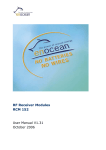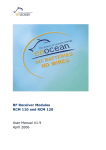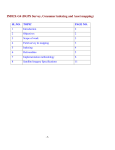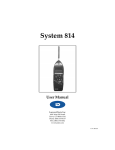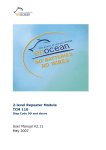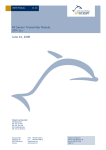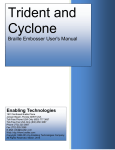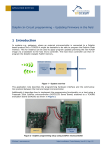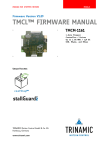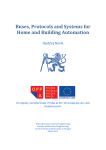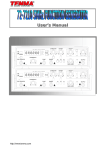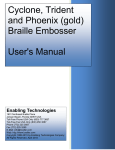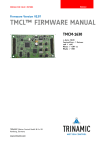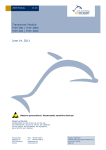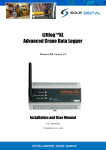Download Users Manual RCM 110/120
Transcript
RF Receiver Module RCM 130 step code DB User Manual V1.32 May 2007 Revision History The following major modifications and improvements have been made to the initial version of the document (RCM 130 User Manual V1.0): Version Subject (major changes since last version) V1.0 V1.1 V1.2 V1.21 V1.22 V1.30 V1.31 V1.32 First version for RCM 130 Current consumption and voltage range modified Titel of fig. 7 corrected; header information in 2.4.3 clarified Updated declaration of conformity Power supply application note updated Firmware modification on serial interface Antenna drawing corrected Editorial corrections Published by EnOcean GmbH, Kolpingring 18a, 82041 Oberhaching, Germany www.enocean.com, [email protected], phone ++49 (89) 6734 6890 © EnOcean GmbH, All Rights Reserved Important! This information describes the type of component and shall not be considered as assured characteristics. No responsibility is assumed for possible omissions or inaccuracies. Circuitry and specifications are subject to change without notice. For the latest product specifications, refer to the EnOcean website: http://www.enocean.com. As far as patents or other rights of third parties are concerned, liability is only assumed for modules, not for the described applications, processes and circuits. EnOcean does not assume responsibility for use of modules described and limits its liability to the replacement of modules determined to be defective due to workmanship. Devices or systems containing RF components must meet the essential requirements of the local legal authorities. The modules must not be used in any relation with equipment that supports, directly or indirectly, human health or life or with applications that can result in danger for people, animals or real value. Components of the modules are considered and should be disposed of as hazardous waste. Local government regulations are to be observed. Packing: Please use the recycling operators known to you. By agreement we will take packing material back if it is sorted. You must bear the costs of transport. For packing material that is returned to us unsorted or that we are not obliged to accept, we shall have to invoice you for any costs incurred. ©EnOcean GmbH Page 2 of 27 RCM 130 User Manual V1.32 Table of Contents 1. GENERAL DESCRIPTION________________________________________________________________ 4 1.1 Basic Functionalities ________________________________________________________________ 4 1.2 Typical Applications _________________________________________________________________ 4 1.3 Features Overview __________________________________________________________________ 5 1.4 Physical Dimensions ________________________________________________________________ 5 1.5 Environmental Conditions __________________________________________________________ 6 1.6 Ordering Information _______________________________________________________________ 6 2. FUNCTIONAL DESCRIPTION ___________________________________________________________ 7 2.1 Block Diagram _______________________________________________________________________ 7 2.2 Pin Description ______________________________________________________________________ 7 2.3 RCM 130 Operating Modes_________________________________________________________ 10 2.4 RCM 130 Serial Interface (Operating Mode 0 and 3)_____________________________ 12 2.5 Learning Modes ____________________________________________________________________ 17 2.6 Learning of Radio Transmitters ___________________________________________________ 18 2.7 Deleting Radio Transmitters_______________________________________________________ 20 2.8 Received Signal Strength Indicator (RSSI) _______________________________________ 21 2.9 Demodulated Direct Signal Output (RxD) ________________________________________ 21 3. APPLICATIONS INFORMATION _______________________________________________________ 22 3.1 Module Mounting ___________________________________________________________________ 22 3.2 Antenna Mounting__________________________________________________________________ 22 3.3 Transmission Range _______________________________________________________________ 23 3.4 Power Supply Requirements ______________________________________________________ 24 3.5 LMI Output Connection ____________________________________________________________ 24 3.6 Notes to RCM 130 Mode 0 and 3 (Serial Data Communication) _________________ 25 3.7 Approval Requirements ____________________________________________________________ 25 4. DEVELOPMENT TOOLS _________________________________________________________________ 26 4.1 Evaluation Kit EVA 100 ____________________________________________________________ 26 4.2 On-Board Overview EVA-PCB ______________________________________________________ 26 4.3 EVA 100 Scope of Supply and Ordering Information _____________________________ 26 5. DECLARATION OF CONFORMITY ______________________________________________________ 27 ©EnOcean GmbH Page 3 of 27 RCM 130 User Manual V1.32 1. GENERAL DESCRIPTION The multifunctional receiver module RCM 130 is used to receive and to process telegrams generated and transmitted by EnOcean radio transmitters. These modules can be easily integrated into control and switching units for the implementation of different applicationspecific system solutions. 1.1 Basic Functionalities Serial Data Communication via Receiver Module RCM 130 (all EnOcean RF signals): • Serial data link from all radio signals transmitted from PTM, STM, TCM and CTM radio modules (9600 bps, 1 start bit, 1 stop bit) • This interface enables a simple realization of a Gateway to existing control and monitoring systems • This interface enables any desired actor functionality by the user, e.g. by connecting to a following microcontroller (the output control logic can be easily and flexible programmed by the user) RCM 130 output switching functionalities (controlled by PTM radio signals): • Basic signal output function “tubular motor control” (UP/DOWN with slat acting): 1 or 2 channel • Learning procedure for EnOcean transmitters, easy to operate Figure 1: Receiver modules RCM 130 1.2 Typical Applications • Building installation • Industrial automation • Consumer Electronics The RCM modules are part of a powerful RF system solution from EnOcean for operation and control applications. Because the RF transmitters are self-powered (no batteries), maintenance-free RF systems can be implemented. The RCM modules operate together with the following further EnOcean components: PTM (batteryless radio switches), STM (batteryless radio sensors), CTM (remote control) and TCM (bi-directional IT interface) ©EnOcean GmbH Page 4 of 27 RCM 130 User Manual V1.32 1.3 Features Overview Power Supply: ........................................................................................ 5 V DC ± 5 % Current Input: ............................................................ 29 mA max. (without output load) Receive Frequency: ................................................ 868.3 MHz (stabilized by crystal PLL) Sensitivity / Channel Bandwidth: ..................................................... -95 dBm / 280 kHz Control Inputs: ................................... 6 inputs for set up of operating and learning modes Functional Outputs: ......... 4 outputs, their function depends on the selected operation mode Learning Mode Output: ................................................ indicates learning of transmitters Number of RF transmitters learnable: ............................. up to 30 EnOcean transmitters RSSI Output:.........................................................indicates received peak signal strength Direct Signal Output: .................................................. physical layer 1 output (120 kbps) 1.4 Physical Dimensions Antenna:............................................................................. 9 cm whip antenna mounted Dimensions of PCB: ........................................18.0 x 42.0 x 5.5 mm (without wiring pins) Connector: ........................................16 pins, grid 2.0 mm (4.0 mm in length, ©EnOcean GmbH Page 5 of 27 0.5 mm) RCM 130 User Manual V1.32 2 0.5 4 Pin 1 18 Pin 16 Antenna 42 Pin 1 5.5 2.45 Pin 16 30 1.225 Figure 2: RCM 130 package outlines 1.5 Environmental Conditions Operating Temperature:..................................................................... -25 up to +65 °C Storage Temperature: ........................... -40 up to +85 °C, +85 up to +100 °C for 1h max. Humidity:............................................................................................ 0 % to 95 % r.h. 1.6 Ordering Information Type EnOcean Ordering Code Remarks RCM 130 S3002-B130 Serial Interface or Tubular Motor ©EnOcean GmbH Page 6 of 27 RCM 130 User Manual V1.32 2. FUNCTIONAL DESCRIPTION 2.1 Block Diagram 14 RSSI RXD 13 Ant 8 OUT_0 OUT_1 OUT_2 OUT_3 9 CODE_0 CODE_1 CODE_2 2 3 Mode 4 15 10 µC 11 12 1, 16 5 LRN VCC GND 6 SSLM LMI 7 CLR Figure 3: Block diagram of RCM 130 2.2 Pin Description Pin No. Symbol Function 1 GND_0 Ground connection 2 3 4 CODE_0 CODE_1 CODE_2 ©EnOcean GmbH Operational characteristics Encoding input for operation mode selection (configuration of the receiver firmware). The operation mode is defined at the first power-up in accordance to the pin connecting. A later change of the operation mode is possible at power-up, but only if the ID memory is cleared in addition (connect CLR-pin to GND -> power-down -> change CODE-pin connecting -> power-up). Page 7 of 27 Resistor network input. Code pins should be left open or connected to GND (for encoding schematics, see 2.3 RCM 130 Operating Modes). RCM 130 User Manual V1.32 5 LRN 6 SSLM 7 CLR Control input to clear the receiver ID and scene memory (all learned switch rockers, sensors and scene switches) Resistor network input: Connect the open CLR pin to GND for longer than 2 seconds. 8 9 10 11 OUT_0 OUT_1 OUT_2 OUT_3 Functional control outputs (see 2.3 RCM 130 Operating Modes). Also indicate current learning mode status (see 2.6 Learning of Radio Transmitters). Open collector outputs. 35 V max., 100 mA max., 100 mW max. each. 12 LMI Learning Mode Indication output: LMI is Active High in the learning mode phase. For optical indication, LEDs can be connected with one lead directly to the functional control outputs. The other lead of the LEDs can be connected to the LMI pin in common, so Learning Mode LEDs are switched off in operation mode. If desired, the LMI pin can also be used to switch off loads within learning mode (in addition see Application Note chapter 3.5). 5 V TTL output, 20 mA max. 13 RXD Digital direct output of all received radio bit streams (physical layer 1, 120 kbps). Note: RCM 130 in Operating Mode 0 and 3 offers a 9.6 kbps standardized serial data output at OUT_0 (see chapter 2.4) which is very good suited for a further data processing by the user. 5 V TTL output, source impedance 11 KΩ 14 RSSI Indication output of received signal strength (peak detection) Source impedance app. 20 KΩ 15 VCC Power supply 5 V DC ± 5%, 29 mA max. (without LMI output current) 16 GND_1 ©EnOcean GmbH Control input to enter and to stop transmitter learning mode: see 2.6 Learning of Radio Transmitters. During transmitter learning mode, the sensitivity of the receiver is reduced to in-room operation. Resistor network input: Connect the open LRN pin to GND for longer than 0.5 sec. not used in RCM130 Ground connection Page 8 of 27 RCM 130 User Manual V1.32 VCC VCC 10K 10K CODE_2 8K2 CODE_1 10K CODE_0 22K ADC (internal (Mode) CLR 8K2 SSLM 10K LRN 22K 100n ADC (internal) (Mode) 100n Figure 4: Equivalent schematics of Control Inputs (pins 2 to 7) OUT_x external OC (external (OC) ) 4K7 OUT_x internal TTL (TTL) ) (internal 22K Figure 5: Equivalent schematics of Functional Outputs (pins 8 to 11) ©EnOcean GmbH Page 9 of 27 RCM 130 User Manual V1.32 2.3 RCM 130 Operating Modes The following operating modes can be configured by the encoding inputs CODE_2..0 of the RCM 130 module: Mode Function Output signal description 0 Serial Interface OUT_0: Asynchronous Interface, supplies standard data blocks of information from all received EnOcean radio telegrams (9600 bps; 8 data bits, no parity bit, one start bit, one stop bit). For further information see chapter 2.4 OUT_1: Learning mode status indicator 1 2 None Tubular Motor Control - 2 channel 3 Serial Interface 4 5 None None 6 Tubular Motor Control - 1 channel 7 Test Same as Mode 6 but operation of 2 receiver channels: channel 1 at OUT_0 and OUT_1 channel 2 at OUT_2 and OUT_3 Same as Mode 0 but: learning of 1BS and 4BS transmitters without learn bit deletion of IDs only via CLR Control signals - “Open/Up” at OUT_0 and - “Close/Dn” at OUT_1 with slat acting function (rocker pushed not longer than Ts ~ 0.75 sec.). Continuous shutter running for 2 min is started when the rocker is pushed longer than Ts sec. Switchover time at changing the driving direction is Ts ~ 0.75 sec. Reserved (module test mode) - No. of channels 1 (OUT_0..1) 2 (OUT 0-1, OUT 2-3) 1 (OUT 0-1) CODE _2 CODE _1 CODE _0 NC NC NC NC NC NC GND GND NC NC GND GND GND GND NC NC NC GND GND GND NC GND GND GND The operation mode is defined with pin status at power-up; a change of operation mode is possible with cleared ID memory only. Note: Since RCM 130 operating modes 2 and 6 are switching functions, transmitter modules with switching functionality can be learned in these modes only (RPS and HRC radio telegrams from PTM, CTM or TCM modules). Note: Mode 0 and 3 (Serial Interface) provides an optional to use, simple teach-in functionality for PTM, STM, CTM and TCM modules: ©EnOcean GmbH Page 10 of 27 RCM 130 User Manual V1.32 While the receiver is in learn phase the IDs of all arriving transmitter telegrams are stored. Only EnOcean telegrams from previously learned transmitters are output at the serial interface. An additional bit (see H_SEQ at chapter 2.4) marks them as known, new (just learned) or just deleted. If no IDs have been stored the RCM 130 outputs all received EnOcean telegrams at the serial interface. In H_SEC they are marked as unknown. Tubular Motor Control (MODE 6): Ts OUT_1 (Close/Dn, Ts ~ 0.75s) Start of continuous running for ~ 2 min Slat action Premature stop of continuous running OUT_0 (Open/Up, Ts ~ 0.75s) Switchover time at changing the driving direction (Ts ~0.75s) Figure 6: Timing of RCM 130 functional outputs RCM 130 MODE 6 O-button pressed < Ts sec. I-button pressed < Ts sec. O-button pressed ≥ Ts sec. I-button pressed ≥ Ts sec. OUT_0 active for 2 min. (cont. running) OUT_1 active for 2 min. (cont. running) OUT_0 and OUT_1 are inactive (standstill) OUT_0 active for OUT_1 active for pressed time pressed time (slat acting) (slat acting) OUT_0 is active (open/up) At O-button releasing time OUT_0 changes to inactive (stop at button release) At I-button pressing time OUT_0 changes to inactive (stop immediately) OUT_0 remains active (driving on) At pressing time OUT_0 changes to inactive immediately. After Ts sec OUT_1 changes to active for 2 min. (cont. running after switchover time) OUT_1 is active (close/dn) At O-button pressing time OUT_1 changes to inactive (stop immediately) At I-button releasing time OUT_1 changes to inactive (stop at button release) At pressing time OUT_1 changes to inactive immediately. After Ts sec OUT_0 changes to active for 2 min. (cont. running after switchover time) OUT_1 remains active (driving on) ©EnOcean GmbH Page 11 of 27 RCM 130 User Manual V1.32 2.4 RCM 130 Serial Interface (Operating Mode 0 and 3) When the receiver is in “Serial Interface” mode, it transfers out data blocks of information from the received RF telegrams. As long as no transmitter has been learned, all received EnOcean telegrams are transferred. As soon as at least one transmitter has been learned only telegrams of transmitters learned by the receiver are transmitted via the serial interface. The data block format is explained later in this document; it depends on the type of sensor from which the telegram has been received. The serial telegram is sent within 0.1 to 6 ms after the reception of the first of typically three radio sub-telegrams. While transmitting data through the serial interface (about 15ms) the module is not able to receive radio telegrams. Sub-telegrams received from one transmitter with same content within 40 ms are treated as one telegram (only one serial transmission). There is a buffer for 4 telegrams. A buffer is blocked for 40 ms after reception of the first subtelegram. If more than 4 different telegrams (repeated telegrams are also treated as different telegrams in RCM130) are received within 40 ms further telegrams will be ignored until a free buffer is available. Timing Diagram – no ID learned Radio subtransmission A BCAB A Serial transmission AC C B B D C 0 ms D D E D E E E 50ms 100ms Buffer 2 blocked Buffer 1 blocked Buffer 2 blocked Buffer 3 blocked Buffer 1 blocked Timing Diagram – A and C learned Radio subtransmission A Serial transmission BCAB AC C B A D D D E E E C 0 ms 50ms 100ms Buffer 2 blocked Buffer 1 blocked Buffer 2 blocked Buffer 3 blocked Buffer 1 blocked Figure 7: Timing diagram for serial mode ©EnOcean GmbH Page 12 of 27 RCM 130 User Manual V1.32 2.4.1 Message format The following figure shows the message format. A data block of length n is composed of 2 synchronization bytes, 1 octet for the header and n-1 octets for the message data. TxD Sync Sync Header ... Byte0 ByteN-1 Figure 8: Message format for asynchronous serial communication 2.4.2 Octet signals and bit order • • • 9600 bps; 8 data bits, no parity bit, one start bit, one stop bit Line idle is binary 1 (standard) Each character has one start bit (binary 0), 8 information bits (least significant bit first) and one stop bit (binary 1) Byte Ti 5V TxD 0V STA D0 Bit Time D1 D2 D3 D4 D5 D6 D7 STOP Bit Time Bit Time Figure 9: Signals and bit order sending a byte 2.4.3 Description of serial data structure Bit 7 Bit 0 H_SEQ SYNC_BYTE1 (A5 Hex) SYNC_BYTE0 (5A Hex) LENGTH ORG DATA_BYTE3 DATA_BYTE2 DATA_BYTE1 DATA_BYTE0 ID_BYTE3 ID_BYTE2 ID_BYTE1 ID_BYTE0 STATUS CHECKSUM SYNC_BYTE 0..1 (8 bit each) H_SEQ (3 bit) ©EnOcean GmbH Synchronization Bytes Header identification: Page 13 of 27 RCM 130 User Manual V1.32 H_SEQ 0b000 • • • 0b001 • • • • 0b010 • 0b110 • LENGTH ORG DATA_BYTE 0..3 ID_BYTE 0..3 STATUS CHECKSUM (5 (8 (8 (8 (8 (8 Meaning Unknown transmitter ID received (serial telegram only if no ID has been learned so far!) For RPS also: o Known transmitter ID and unknown rocker o U-message from known transmitter ID received For HRC also: o Known transmitter ID and unknown rocker o Scene switch command (last three bits of ID 0b111) from known transmitter ID (only first 29 bits are compared!) For 1BS and 4BS: Known transmitter ID received For RPS: Known transmitter ID and at least 1 known rocker (1 or 2 rockers operated) For HRC: Known transmitter ID and known rocker New transmitter learned (If a switch telegram is received (RPS or HRC), the rocker code (RID) is stored together with the ID.) Mode 3: a telegram with this header information will be sent also when in LRN mode a transmitter which is already learned is operated again Mode 0: Transmitter just deleted (If a switch telegram is received (RPS or HRC), the rocker code (RID) and module ID are checked. The entry is only deleted if module ID and rocker are known.) bit) bit) bit each) bit each) bit) bit) Mode Operating Mode Operating Mode Learn Mode Learn Mode Number of octets following the header octet (11 dec) Type of telegram (see detail description) Data bytes 0..3 (see detail description) 32-bit transmitter ID Status field (see detail description) Checksum (Last LSB from addition of all octets except sync bytes and checksum) 2.4.4 Detailed description of ORG field ORG field value (decimal) 5 Acronym 6 1BS 7 4BS 8 HRC 0-4, 9-255 - ©EnOcean GmbH RPS Description Telegram from a PTM switch module received (e.g. PTM 100 or PTM 200) 1 byte data telegram from a STM sensor module (e.g. STM 250) 4 byte data telegram from a STM sensor module (e.g. STM 100) Telegram from a CTM module received Reserved Page 14 of 27 RCM 130 User Manual V1.32 2.4.5 Detailed description of STATUS field If ORG = 5 (Telegram from a PTM switch module): 7 Reserved 0 T21 NU RP_COUNTER Reserved T21 (2 bit) (1 bit) NU RP_COUNTER (1 bit) (4 bit) =0..15 For future use T21=0 Æ PTM switch module of type 1, T21=1 Æ PTM switch module of type 2 NU=1 Æ N-message, NU=0 Æ U-message. Repeater level: 0 is original message (not repeated) IMPORTANT NOTE FOR SYSTEMS USING AN ENOCEAN RADIO REPEATER: Within toggle switch applications using the RCM 130 serial receiver mode in combination with the TCM 110 repeater module, please ensure that no serial command interpretation error may occur at the connected control unit. A toggle signal means that the same telegram (from e.g. PTM 100, PTM 200 or STM 100) is sent for switching something on and off. If e.g. the light is switched on by means of a RCM 130 receiving the I-button telegram from a PTM 100, the repeated telegram (delay <100ms) may switch off the light again. It is therefore mandatory to interpret the RP_COUNTER field. If a repeated telegram (RP_COUNTER>0) is received it has to be verified if the same telegram with a lower RP_COUNTER state has already been received in the previous 100 ms. In this case the repeated message has to be discarded. PTM switch modules of Type 1 (e.g. PTM 100) do not support interpretation of operating more than one rocker at the same time: • N-message received Æ Only one pushbutton was pressed. • U-message received Æ No pushbutton was pressed when activating the energy generator, or more than one pushbutton was pressed. PTM switch modules of Type 2 (e.g. PTM 200) allow interpretation of operating two buttons simultaneously: • N-message received Æ Only one or two pushbuttons have been pressed. • U-message received Æ No pushbutton was pressed when activating the energy generator, or more than two pushbuttons have been pressed. Note for telegrams from PTM transmitters: Due to the mechanical hysteresis of the energy bow, in most rocker switch device implementations, pressing the rocker sends an N-message and releasing the rocker sends a U-message! If ORG = 6, 7 or 8 (all other telegrams): 7 0 Reserved Reserved RP_COUNTER RP_COUNTER (4 bit) (4 bit) For future use Repeater level: 0 is original message (not repeated) Please consider the “IMPORTANT NOTE” above! ©EnOcean GmbH Page 15 of 27 RCM 130 User Manual V1.32 2.4.6 Detailed description of DATA_BYTE 3..0 fields If ORG = 5 and NU = 1 (N-message from a PTM switch module): DATA_BYTE2..0 DATA_BYTE3 always = 0 as follows: 7 RID UD RID UD PR SRID SUD SA PR (2 (1 (1 (2 (1 (1 SRID bit) bit) bit) bit) bit) bit) SUD 0 SA Rocker ID, from left (A) to right (D): 0, 1, 2 and 3 (decimal) UD=1 Æ O-button, UD=0 Æ I-button PR=1 Æ Energy bow pressed, PR=0 Æ Energy bow released Second Rocker ID, from left to right: 0, 1, 2 and 3 (Second) SUD=1 Æ O-button, SUD=0 Æ I-button SA=1 Æ Second action (2 buttons pressed simultaneously), SA=0 Æ No second action If ORG = 5 and NU = 0 (U-message from a PTM switch module): DATA_BYTE2..0 DATA_BYTE3 always = 0 as follows: 7 0 BUTTONS PR Reserved BUTTONS (3 bit) Number of simultaneously pressed buttons, as following: PR (1 bit) Reserved (4 bit) PR = 1 Æ Energy bow pressed, PR = 0 Æ Energy bow released for future use PTM 100 (Type1): 0 = 0 Buttons 1 = 2 Buttons 2 = 3 Buttons 3 = 4 Buttons 4 = 5 Buttons 5 = 6 Buttons 6 = 7 Buttons 7 = 8 Buttons PTM200 (Type2): 0 = 0 Button 1 = not possible 2 = not possible 3 = 3 or 4 buttons 4 = not possible 5 = not possible 6 = not possible 7 = not possible If ORG = 6 (Telegram from a 1 Byte STM sensor): DATA_BYTE2..0 DATA_BYTE3 always = 0 Sensor data byte. If ORG = 7 (Telegram from a 4 Byte STM sensor): DATA_BYTE3 DATA_BYTE2 DATA_BYTE1 DATA_BYTE0 7 Reserved ©EnOcean GmbH Value of third sensor analog input (AD_2) Value of second sensor analog input (AD_1) Value of first sensor analog input (AD_0) Sensor digital inputs as follows: 0 DI_3 DI_2 DI_1 DI_0 Page 16 of 27 RCM 130 User Manual V1.32 If ORG = 8 (Telegram from a CTM module set into HRC operation): DATA_BYTE2..0 always = 0 DATA_BYTE3 as follows: 7 RID UD PR SR RID UD PR SR Reserved (2 (1 (1 (1 (3 bit) bit) bit) bit) bit) 0 Reserved Rocker ID, from left (A) to right (D): 0, 1, 2 and 3 UD=1 Æ O-button, UD=0 Æ I-button PR=1 Æ Button pushed, PR=0 Æ Button released SR=1 Æ Store, SR=0 Æ Recall (see note) for future use Note: The bit SR is used only when the lower 3 Bits from ID_BYTE0 = 0b111 (scene switch), and RID ≠ 0 (indicates that the memory buttons M0-M5 are operated in the handheld remote control). 2.5 Learning Modes Three different learning modes are implemented within the RCM 130 modules: 1.) Learning Mode CLR: ID Memory Reset. All learned transmitter IDs are deleted. Learning mode B is entered subsequently. CLR mode has to be entered also for changing the receiver operating mode (changed connections pattern at pins CODE_2..0 is taken over). 2.) Learning Mode LRN: Transmitter Learning Mode entered via LRN pin: The receiver sensitivity is limited to in-room operation, learning of repeater-powered signals is disabled. The telegram of the associated radio transmitter has to be triggered one time at least (pressing the desired switch rocker or triggering a sensor). 3.) Learning Mode RLM: Transmitter Learning Mode entered via Configuration Remote Control (CTM module in CRC operating mode): The receiver sensitivity is not limited. Learning of repeater-powered signals is enabled. The transmitters telegrams have to be triggered 3 times within 2 seconds to avoid inadvertent learning. RLM can only be entered within a time of approx. 30 minutes after receiver power up to make a running system safe against sabotage. Indistinct signal or pin configurations are ignored at all times. Within the learning procedure, the learning mode cannot be changed. ©EnOcean GmbH Page 17 of 27 RCM 130 User Manual V1.32 2.6 Learning of Radio Transmitters Please also draw attention to the notes about learnable transmitters in chapter 2.3 “Operating Modes”. LMI pin is active high during all learning modes. 1.) Setting the receiver to learning mode - Via CLR Pin: Contact to GND longer than t = 2 sec. Learning Mode LRN is entered after clearing transmitter-ID memory. - Via LRN Pin: Contact to GND longer than t = 0.5 sec. In multi-channel receiver modes, the pin has to be contacted several times until the desired channel number is selected (the number of channels is given by the selected operating mode = Code_2..0 pin configuration). - Via Configuration Remote Control: The remote control must be operated within a distance of max. 0.5 m to the receiver. A specific selection method can be used (multiple pressing of the control pushbutton) when two receivers are very close together and have been set into learning mode at the same time. 2.) The receiver will confirm Learning Mode (i.e. via LEDs in parallel to the output pins) Operating Mode Learning Mode Confirmation RCM 130 – Mode 0 and 3 (IT Interface) The OUT_1 output signal is flashing (1 sec. on / 1 sec. off) RCM 130 – Mode 2 and 6 (Tubular Motor, 1 or 2 ch.) The outputs of the selected channel are switching alternately (cyclic slat moving: 1 sec. pause / 1 sec. CLOSE active / 1 sec. pause / 1 sec. OPEN active) 3.) By fresh contacting of the LRN pin to GND (or again operating the Configuration Remote Control) the next remaining channel is selected. In one-channel receiver modes or after the last channel, the operating mode is entered again. The next remaining channel is selected for learning until the last channel is selected; otherwise, Operation Mode is entered again at the next contact (no output is flashing any more and LMI output changes to inactive). The number of channels is given by the selected operating mode = Code_2..0 pin configuration. 4.) Ensure that the associated radio transmitter will be in a distance less than 5 m to the receiver (not necessary within RLM Learn Mode) In learning mode LRN, the sensitivity of the RCM module is limited to in-room operations and learning of repeater powered signals is disabled (to avoid unintentional learning). 5.) Trigger the telegram of the associated radio transmitter within 30 sec. at the latest - Operate the switch radio transmitter (RPS or HRC) at least once (press I-button or Obutton of the rocker that is to be assigned to the selected receiver channel). If the same rocker is operated again within 4s it will still be learned. If the same rocker is ©EnOcean GmbH Page 18 of 27 RCM 130 User Manual V1.32 operated again after more than 4 s it will be deleted again. Please note that scene switches (HRC and last 3 ID bits 0B111) cannot be teached-in! If Learning Mode was entered via Config Remote Control, operate the button 3 times within 2 sec. Note: In Mode 3 deletion only via CLR! - Or activate the sensor radio transmitter (1BS, 4BS) least once with active LRN bit (DI3=0). If the same transmitter is operated again after more than 4s with active LRN bit it will be deleted again. Note: In Mode 3 deletion only via CLR and LRN bit is ignored! - A fresh contacting of the LRN pin to GND or a fresh operation of the Config Remote Control: In multi-channel operation modes, the next remaining channel is selected for learning until the last channel is selected; otherwise, Operation Mode is entered again at the next contact (no output is flashing any more and LMI output changes to inactive). - After approx. 30 seconds of inactivity (no transmitter has been triggered), the receiver switches back from Learning Mode to Operating Mode automatically. 6.) The receiver will confirm the correct learning of transmitter ID code Operating Mode Confirmation of transmitter learned RCM 130 – Mode 0 and 3 (IT Interface) The OUT_1 learning indication output remains in active state for 4 sec., on the OUT_0 serial interface line a dedicated learning message including ID and type of the learned transmitter is sent. RCM 130 – Mode 2 and 6 (Tubular Motor, 1 or 2 ch.) The outputs of the selected channel remain in active state alternately (4 sec. CLOSE / 1 sec. Pause / 4 sec. OPEN) 7.) Learning of further transmitters After confirmation, the receiver changes again to readiness for learning. Further transmitters can be learned immediately. If available the next receiver channel can be entered by connecting the LRN pin to GND longer than t = 0.5 sec. A maximum of 30 radio transmitters can be learned (further attempts will be ignored; instead of learning confirmation, operating mode is entered). 8.) Leave learning mode LRN mode is leaved by entering the operating mode with LRN pin contacting after the last available receiver channel has been called or automatically after 30 seconds of no activity. ©EnOcean GmbH Page 19 of 27 RCM 130 User Manual V1.32 2.7 Deleting Radio Transmitters a) Deletion of one specific transmitter: Use the same procedure as learning the associated transmitter As transmitter delete confirmation, the corresponding function outputs remain in inactive state for 4 sec. while LMI keeps active. After that, a wrongly deleted transmitter can be learned again immediately. In Mode 0 a dedicated telegram is sent to inform about the deletion of the ID. Note: In order to delete a PTM transmitter the same rocker as during learn has to be operated. If several rockers of a PTM transmitter have been learned, all have to be deleted separately. Note: In Mode 3 deletion of single IDs is not possible ! b) Deletion of all learned transmitters: Connect the CLR pin longer than 2 sec. to GND All learned transmitters on all channels are deleted at the same time. After this, the receiver enters Learning Mode LRN. In Mode 0 and 3 there is no information sent via the serial interface. ©EnOcean GmbH Page 20 of 27 RCM 130 User Manual V1.32 2.8 Received Signal Strength Indicator (RSSI) The RSSI output of the RCM module is useful for transmission range tests. By indicating the strength of an incoming RF signal, this output allows the assessment of RF link quality and transmission range. The RSSI pin output voltage is typically 0.9 V with no RF signal, rising to typically 2.6 V at maximum signal. The external loading should be kept to a minimum since the RSSI output source impedance is around 20 kΩ. The following shows a typical RSSI characteristic: RSSI output (mV) 3000 2500 2000 1500 1000 500 -120 -110 -100 -90 -80 -70 -60 -50 -40 -30 -20 -10 0 RF input (dBm) Figure 10: RSSI output characteristics 2.9 Demodulated Direct Signal Output (RxD) TTL output of all received radio signals (120 KHz, physical layer 1). This recommended for user’s further data processing, because a very structure has to be processed at high speed. Please note that RCM 130 in 0 and 3 offers a 9.6 kbps standardized serial output of all received EnOcean (see chapter 2.4). ©EnOcean GmbH Page 21 of 27 output is not complex data Operating Mode radio telegrams RCM 130 User Manual V1.32 3. APPLICATIONS INFORMATION 3.1 Module Mounting The modules may be mounted in vertical or horizontal position to the user board of the application device (load module). In a vertical position, the module pins can be directly connected to the user board through suitable PCB holes. Optionally suitable female strip connectors can be used, available e.g. from Conrad Electronic GmbH (Ordering No. 73 92 43). Additional module fixing may be necessary in rough environments. The following features have to be available on the motherboard: - Load circuit, i.e. power switches or serial interface driver (connected to RCM functional output pins OUT_0..3) - Power supply for the receiver module (GND_0, GND_1, VCC) and for the load circuit - Configuration of the receiver firmware (connecting of input pins CODE_0, CODE_1 and CODE_2) - If needed, programming pushbuttons for channel storing (connecting of input pins LRN, SSLM and CLR if used) - If needed, Learn Mode indication circuitry: LED(s) for providing optical feedback and/or a load output decoupling logic - External connectors 3.2 Antenna Mounting Positioning and choice of receiver and transmitter antennas are the most important factors in determining system transmission range. The RCM 110, RCM 120 and RCM130 receiver modules are supplied with a soldered whip antenna as a standard. This antenna enables a very compact receiver unit with good radio reception characteristics. For mounting the antenna, the following notes should be considered to optimize the system performance: a) Mounting the soldered 1/4-wave whip antenna: For good receiver performance, great care must be taken about the space immediately around the antenna since this has a strong influence on screening and detuning the antenna. The antenna should be drawn out as far as possible and must never be cut off. Mainly the far end of the wire should be mounted as far away as possible from all metal parts, PCB strip lines and fast logic components (e.g. microprocessors). To avoid radio frequency hash from the motherboard, which desensitizes the receiver, PCB strip lines on the user board should be designed as short as possible, and using PCB ground plane layer is also recommended. Note that 868 MHz whip antennas do not show any directional effects under free-field radiowave propagation conditions (spot-wise radiator). The RSSI voltage output can be used for evaluating the influence of intuitive RF optimizations. For a good antenna performance don’t roll up or twist the whip and please draw attention to an overall whip distance of at least 10 mm (20 mm is better) from any ©EnOcean GmbH Page 22 of 27 RCM 130 User Manual V1.32 PCB strip, ground plane and conductive part or electric part. Figure 11: Specification of the RCM whip antenna ( L=86 ± 2 mm, color blue) b) Mounting an external antenna: For mounting the receiver at bad RF locations (e.g. within a metal cabinet), an external antenna has to be used. After resoldering the pre-installed whip antenna, the external antenna can be connected to the equipment by a 50-Ohm coax feeder with Teflon insulation as follows (connect the inner cable to the resoldered hole, and solder the shielding as short as possible to the RCM Groundplane, length of insulation max. 4 mm): Figure 12: Mounting an external antenna 3.3 Transmission Range The main factors that influence the system transmission range are type and location of the antennas of the receiver and the transmitter, type of terrain and degree of obstruction of the link path, sources of interference affecting the receiver, and “Dead” spots caused by signal reflections from nearby conductive objects. Since the expected transmission range strongly depends on this system conditions, range tests should categorically be performed before ©EnOcean GmbH Page 23 of 27 RCM 130 User Manual V1.32 notification of a particular range that will be attainable by a certain application. The following figures for expected transmission range are considered by using the PTM 100 or STM 100 radio transmitter module and the RCM 110 or RCM 120 radio receiver module with the preinstalled antennas and may be used as a rough guide only: • 30 m for obstructed environment (e.g. through two brick walls inside a building) • 300 m for unobstructed environment (”free field”) Further notes to determine the transmission range within buildings are available as download from www.enocean.com 3.4 Power Supply Requirements In order to provide a good radio performance, a great attention must also be paid to the power supply and a correct layout and shielding, especially when this power supply also supplies possible sources of interference like oscillators or other digital circuits at the same time. Digital switching is very fast and creates high frequency interferences. A star-connected topology and at least a 10uF low-ESR tantalum or similar ceramic capacitor is recommended to be added as close as possible to module, between the module supply pin Vcc and GND, together with a low DC-resistance (<1 Ω) EMI-suppressor, like a ferrit bead e.g. multi layer suppressor type MLS0805-4S7-102 from Ferroxcube, series feed between the board supply pin input and the output of the power supply rail. The ripple on the 5V (±5%) power supply rail should be below 10mVp-p. 3.5 LMI Output Connection Example of a learning status indication by LEDs at 2 channels mode with decoupled loads during learning mode (the decoupling of the load is only necessary if status indication through connected actors is not appropriate). Note: LMI is Active High during learning mode; OUT_0 and OUT_1 are open collector outputs (Active Low). OUT_1 OUT_0 LMI Figure 13: Example of LMI output connection ©EnOcean GmbH Page 24 of 27 RCM 130 User Manual V1.32 3.6 Notes to RCM 130 Mode 0 and 3 (Serial Data Communication) The Mode 0 and 3 serial port enables standard asynchronous communication between the RCM 130 module and a microcontroller or personal computer (9600 bps, 1 start bit, 8 bit data byte with LSB first, 1 stop bit). For a complete sensor message, a telegram of 14 data bytes is transferred. Since there is no minimum delay time between two messages, a verification of the two initial synchronization bytes and the final checksum byte is recommended for synchronizing the first message. It can happen that the data bytes have sync byte format. In this case, a checksum error will occur and the next correct sync byte sequence has to be awaited. Note that sensor RF telegrams arriving during the serial transmission time are ignored by the Mode 0 and 3 standard serial output. Notes for the realization of a physical RS 232 interface: Only a suited voltage level converter has to be connected to the module output. The integrated component MAX 232 as an example generates the specified serial interface voltage levels from the 5 V power supply of the RCM 130. Further details can be found in the circuit diagram of the EVA 100 user manual. 3.7 Approval Requirements The modules bear the EC conformity marking CE and conforms to the R&TTE EU-directive on radio equipment. The assembly conforms to the European and national requirements of electromagnetic compatibility. The conformity has been proven and the according documentation has been deposited at EnOcean. The modules can be operated without notification and free of charge in the area of the European Union, and in Switzerland. The following provisos apply: • EnOcean RF modules must not be modified or used outside their specification limits. • EnOcean RF modules may only be used to transfer digital or digitized data. Analog speech and/or music are not permitted. • The final product incorporating EnOcean RF modules must itself meet the essential requirement of the R&TTE Directive and a CE marking must be affixed on the final product and on the sales packaging each. Operating instructions containing a Declaration of Conformity has to be attached. • If transmitters are used according to the regulations of the 868.3 MHz band, a so-called “Duty Cycle” of 1% per hour for each transmitter must not be exceeded. ©EnOcean GmbH Page 25 of 27 RCM 130 User Manual V1.32 4. DEVELOPMENT TOOLS 4.1 Evaluation Kit EVA 100 EVA 100 is an evaluation kit to support the development of applications based on the EnOcean receiver modules RCM 110 and RCM 120. EVA 100 supports a quick evaluation of all receiver operation modes as well as a quite easy setting-up operation of the receiver side when EnOcean transmitter modules (e.g. PTM 100 or STM 100) are evaluated. 4.2 On-Board Overview EVA-PCB Symbol Adaptor RCM 100 Test Connector Vcc GND GND R0 R1 R2 R3 GND EVG GND PWM RS232 Function Female jack for power supply Female header for plug-in RCM 110 or RCM 120 module Female header connected directly to RCM leads Jack to disconnect RCM power supply Ground connector for control outputs Functional control outputs. Also indicate current learning mode status. R0..3 are directly connected to the OUT_0..3 output pins of RCM 110/120 module. Analog output to drive an Electronic Control Gear (with RCM 110) 50 kHz PWM output (with RCM 110) DB9 female connector (with RCM 120) 4.3 EVA 100 Scope of Supply and Ordering Information Type EVA 100 ©EnOcean GmbH EnOcean Ordering Code H3004-G100 Scope of supply • Evaluation board EVA-PCB • EnOcean radio modules STM 100, PTM 100, RCM 110 and RCM 120 • CD with PC-link monitor software and detailed kit documentation • Wall power supply for EVA-PCB • Convenient equipment case Page 26 of 27 RCM 130 User Manual V1.32 5. DECLARATION OF CONFORMITY ©EnOcean GmbH Page 27 of 27 RCM 130 User Manual V1.32



























